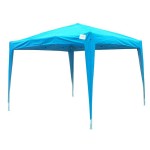Greenhouse is a shelter which provides the suitable environment maintained for your plants, you should know how to make full use of it. The sun provides plenty of sunlight and heat, but you must regulate the environment in your greenhouse. There are some factors below that you ought to pay attention to.
Watering System
A water supply is essential for plants. Watering manually is acceptable for most greenhouse plants if you are available. However, many hobbyists work away from home during the day. Variety of automatic watering systems is available to help you do the task over short periods of time. Bear in mind, the small greenhouse is likely to have a variety of plant materials, containers, and soil mixes that need different amounts of water. Watering kits can water plants in pots, benches, or flats. Mist sprays are used to moisten seedlings or to create humidity. And you can choose time clocks or mechanical evaporation sensors to control automatic watering systems.
CO2 and Light
CO2 and light are essential for plant growth as well. As the sun rises in the morning to provide light, the plants begin to their photosynthesis. The level of CO2 drops in the greenhouse as it is used by the plants. Ventilation supplies the CO2 in the greenhouse. Because CO2 and light complement each other, electric lighting combined with CO2 injection is used to increase yields of vegetable and flowering crops. You may use bottled CO2, dry ice, and combustion of sulfur-free fuels as CO2 sources.
Air Circulation and Ventilation
It is a good investment to fix circulating fans in your greenhouse or portable greenhouse. During the winter when the greenhouse is heated, you need to maintain air circulation so that temperatures remain uniform throughout the greenhouse. The warm air rises to the top and cool air settles around the plants on the floor without air-mixing fans. Turn off these fans during the summer if the greenhouse needs ventilation.
Ventilation is to exchange inside air for outside air to control temperature inside, remove moisture, or replenish CO2. Several ventilation systems can be used. Natural ventilation uses roof vents on the ridge line with side inlet vents. Warm air rises on convective currents to escape through the top, drawing cool air in through the sides. While, mechanical ventilation uses an exhaust fan to move air out one end of the greenhouse while outside air enters the other end through motorized inlet louvers. Exhaust fans should be sized to exchange the total volume of air in the greenhouse each minute. Ventilation requirements vary with the weather and season. In summer, 1 to 1 air volume changes per minute are needed. In winter, 20 to 30 percent of one air volume exchange per minute is sufficient for mixing in cool air without cooling the plants.
Heating
The heating of greenhouses required is dependent on upon the temperature desired for the plants grown, the location and construction of the greenhouses, and the outside exposed area of the structure. As much as 25% of the daily heat may come from the sun, but a lightly insulated greenhouse structure will need lots of heat in cold winter night. The heating in greenhouses must be adequate to maintain the day or night temperature desired. Because the air temperature of greenhouses must be kept at plant-growing temperatures, the greenhouse itself is not a good solar-heat collector. But separate solar collection and storage systems are large and require much space. You can paint containers black to attract heat and fill them with water to retain it, or try to use heat-collecting methods to reduce fossil-fuel consumption. Heating systems can be fueled by electricity, oil, gas, or wood. The heat will be distributed by forced hot air, steam, hot water, or radiant heat.
Cooling
In the middle of the summer, air movement by ventilation alone may not be adequate, so the air temperature may need to be lowered with evaporative cooling. Also, the light intensity may be too great for the plants. During the summer, evaporative cooling, shade cloth, or paint will be necessary. Shade materials include paint, vinyl netting, and roll-up screens of wood or aluminum. Small package evaporative coolers have a fan and evaporative pad to evaporate water, as a result of cooling air and increasing humidity. Heat is removed from the air to change water from liquid to a vapor. Moist the evaporative cooler works best, when the humidity of the outside air is low. The system can be used without water evaporation to provide the ventilation of the greenhouse.






